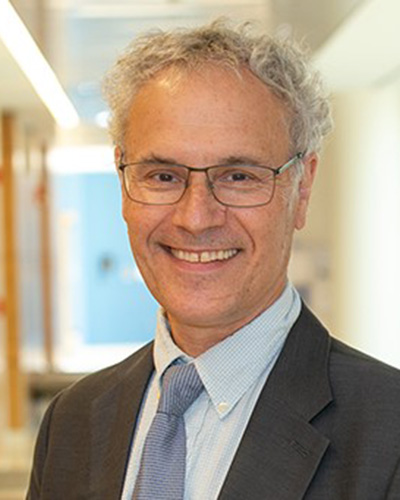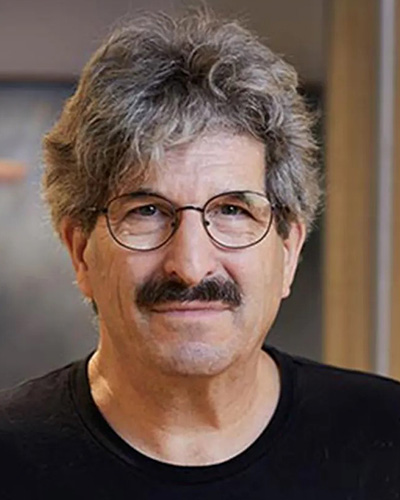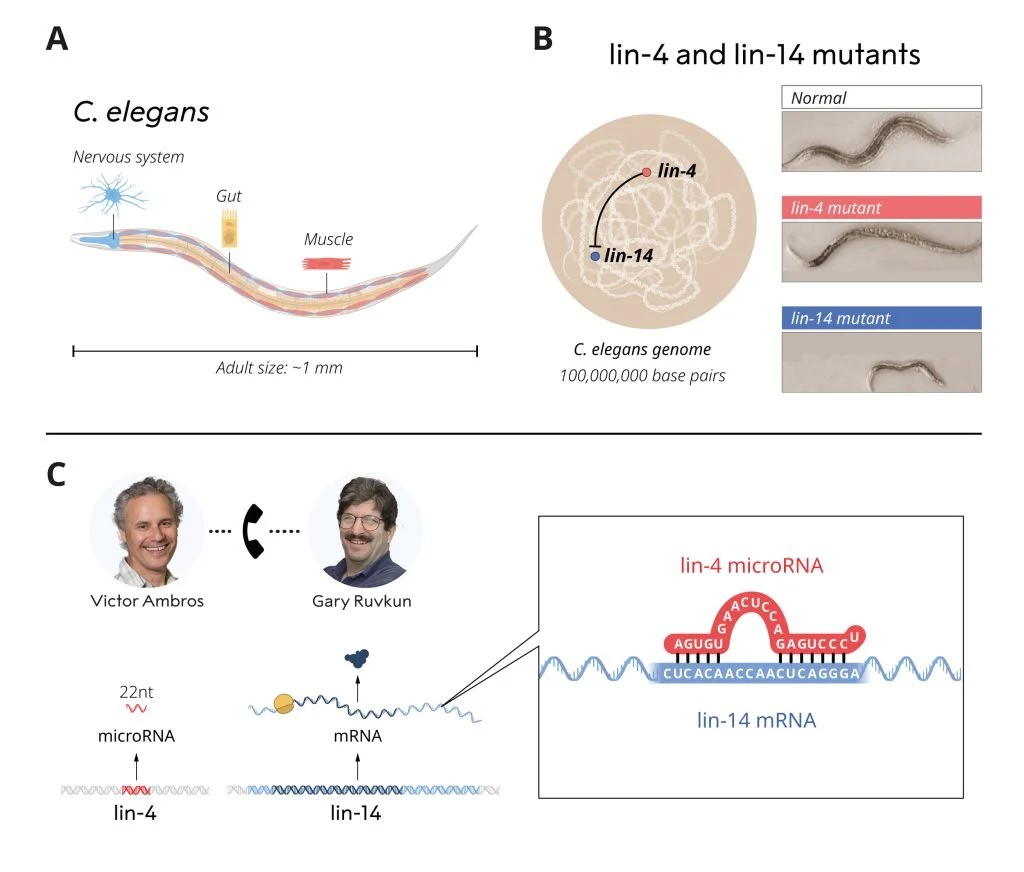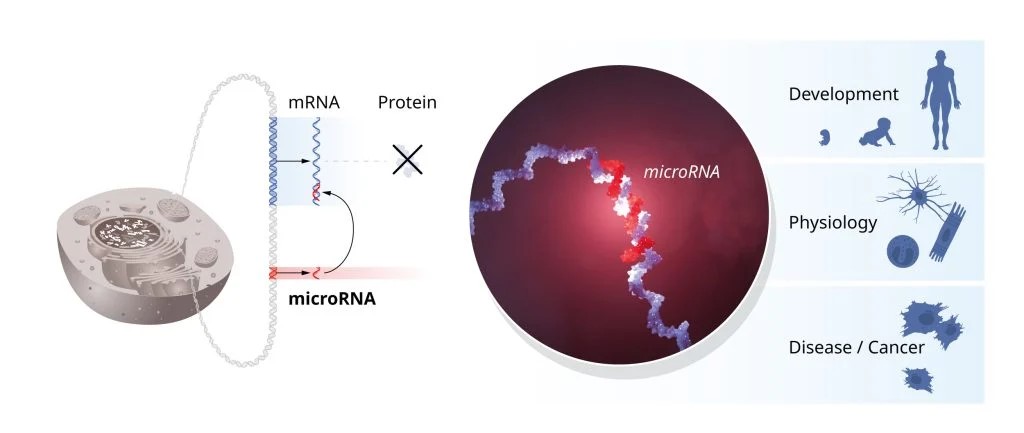Nobel honors discovery of microRNAs


Americans Victor Ambros and Gary Ruvkun today received the 2024 Nobel Prize in physiology or medicine “for the discovery of microRNA and its role in post-transcriptional gene regulation.”
MicroRNAs are single-stranded RNA molecules between 21 and 23 nucleotides long. The two laureates will share a prize fund worth 11 million Swedish kronor, or approximately $1 million.
Ambros and Ruvkun performed postdoctoral research in the laboratory of Robert Horvitz, who won the Nobel Prize in 2002 with Sydney Brenner and John Sulston. In the Horvitz lab, the two 2024 laureates studied the model earthworm Caenorhabditis elegans.
They studied two mutant strains of C. elegans, termed lin-4 and lin-14, which both had developmental defects. Ambros previously showed that the lin-4 gene appeared to negatively regulate the lin-14 gene. However, no one understood the mechanism of this regulation.
They established their own independent research labs, Ambros at Harvard University and Ruvkun at Massachusetts General Hospital and Harvard Medical School, and published their earliest findings in the 1990s and 2000s.
In 1993, Ambros discovered that lin-4 encodes a very short RNA. Concurrently, Ruvkun showed that lin-14 is regulated after it is converted into mRNA, which subsequently shuts down protein production. After comparing results, Ambros and Ruvkun made a breakthrough discovery: Ambros’ lin-4 sequence matched the complementary sequence in the required segment of the lin-14 mRNA that Ruvkun identified. Further experimentation showed that the lin-4 microRNA inhibits lin-14 protein expression.
Ambros and Ruvkun each published their revolutionary results in Cell.
Olle Kämpe of the Karolinska Institutet and vice chair of the Nobel Committee, said that for a long time most scientists considered microRNA an oddity unique to the small world of C. elegans.
However, that perception changed in 2000 when Ruvkun cloned the second microRNA, let-7, which is highly conserved and is present in humans and most of the animal kingdom. His fundamental discovery launched a renaissance of microRNA research.

Thomas Perlmann, secretary-general of the Nobel Committee for Physiology or Medicine 2024, phoned each laureate before making the public announcement.
“I was able to wake up Gary Ruvkun,” Perlmann said. “His wife answered, and it took a long time before he came to the phone and sounded very tired. But he, quite rapidly, was excited and happy when he understood what it was all about. … He handed over the phone to his wife, who also wanted to talk to me for quite a while, and they were thrilled about the prize and coming to Stockholm in December.” Ruvkun’s wife, Natasha Staller, is a professor of art at Amherst College.
At the time of the announcement, Perlmann had not spoken to Ambros, who is now a professor of natural sciences at the University of Massachusetts, and instead left a message on his cell phone.
Many reporters asked the committee about the applications of this discovery, and committee chair Gunilla Karlsson–Hedestam emphasized the importance of fundamental scientific research as the first step toward developing applications.

Joan Conaway, president of the American Society for Biochemistry and Molecular Biology and vice provost and dean of basic research at the University of Texas Southwestern Medical Center, agreed.
“The award of the Nobel Prize to two molecular biologists for their discovery of microRNA and its role in gene regulation underscores the importance of fundamental scientific research," Conaway said. "Understanding microRNA-mediated regulatory mechanisms and their roles in development and homeostasis can lead to medical and biotechnological applications. I hope this recognition inspires the next generation to focus their efforts on both fundamental research and its translational applications."
Prior to the discovery of microRNAs, researchers thought genes were exclusively regulated through DNA-binding proteins such as transcription factors. Nearly 50 years ago, François Jacob and Jacque Monod won the Nobel Prize in physiology or medicine for discovering how genes are regulated, before transcription and translation occur.
“The discovery of microRNA clearly established a paradigm shift in how we understood gene regulation,” F. Peter Guengerich, professor of biochemistry at Vanderbilt University School of Medicine Basic Sciences, said. “The award shows how basic research in simple model organisms can have far-reaching implications for human biology and health. Well-deserved.”
Randy Schekman, winner of the 2013 Nobel Prize in physiology or medicine for discovering vesicular trafficking, agreed.
“Great news this morning that Gary Ruvkun, a native of Berkeley and a University of California, Berkeley grad, shared the Nobel Prize with Victor Ambros. The two are close friends and collaborators who discovered the essential role of small, so-called microRNAs in the control of gene expression. This recognition follows years of anticipation for this prize … (and has) had a substantial impact on our understanding of and ability to manipulate the expression of genes in higher organisms.”
Now, according to Kämpe, more than 10,000 microRNAs have been identified. In fact, one gene can be regulated by multiple microRNAs.
“I think it’s one of the big Nobel Prizes, because it’s completely new,” Kämpe said. “It was a new physiological mechanism that no one expected (and came) completely out of the blue. It shows that curiosity research is very important. (Ambros and Ruvkun) were looking at two worms that looked a bit funny and decided to understand why. And then they discovered an entirely new mechanism. I think that's beautiful.”
According to Karlsson–Hedestam, ongoing clinical trials are exploring using microRNAs to detect and treat cancer as well as cardiovascular and kidney diseases. However, the Food and Drug Administration has not approved any microRNA therapeutics, in part due to toxicity issues. Other challenges include appropriate dosing, immune autoreactivity, side effects and delivery strategies.
Enjoy reading ASBMB Today?
Become a member to receive the print edition four times a year and the digital edition monthly.
Learn moreGet the latest from ASBMB Today
Enter your email address, and we’ll send you a weekly email with recent articles, interviews and more.
Latest in People
People highlights or most popular articles

In memoriam: Michael J. Chamberlin
He discovered RNA polymerase and was an ASBMB member for nearly 60 years.

Building the blueprint to block HIV
Wesley Sundquist will present his work on the HIV capsid and revolutionary drug, Lenacapavir, at the ASBMB Annual Meeting, March 7–10, in Maryland.

In memoriam: Alan G. Goodridge
He made pioneering discoveries on lipid metabolism and was an ASBMB member since 1971.

Alrubaye wins research and teaching awards
He was honored at the NACTA 2025 conference for the Educator Award and at the U of A State and National Awards reception for the Faculty Gold Medal.

Designing life’s building blocks with AI
Tanja Kortemme, a professor at the University of California, San Francisco, will discuss her research using computational biology to engineer proteins at the 2026 ASBMB Annual Meeting.

Jordahl named Gilliam Fellow
He will receive three years of funding to support his thesis research.

